WashU Expert: ERCOT to blame for Texas blackouts, not renewables or fossil fuels
This is an extended version of an analysis first published by Real Clear Energy
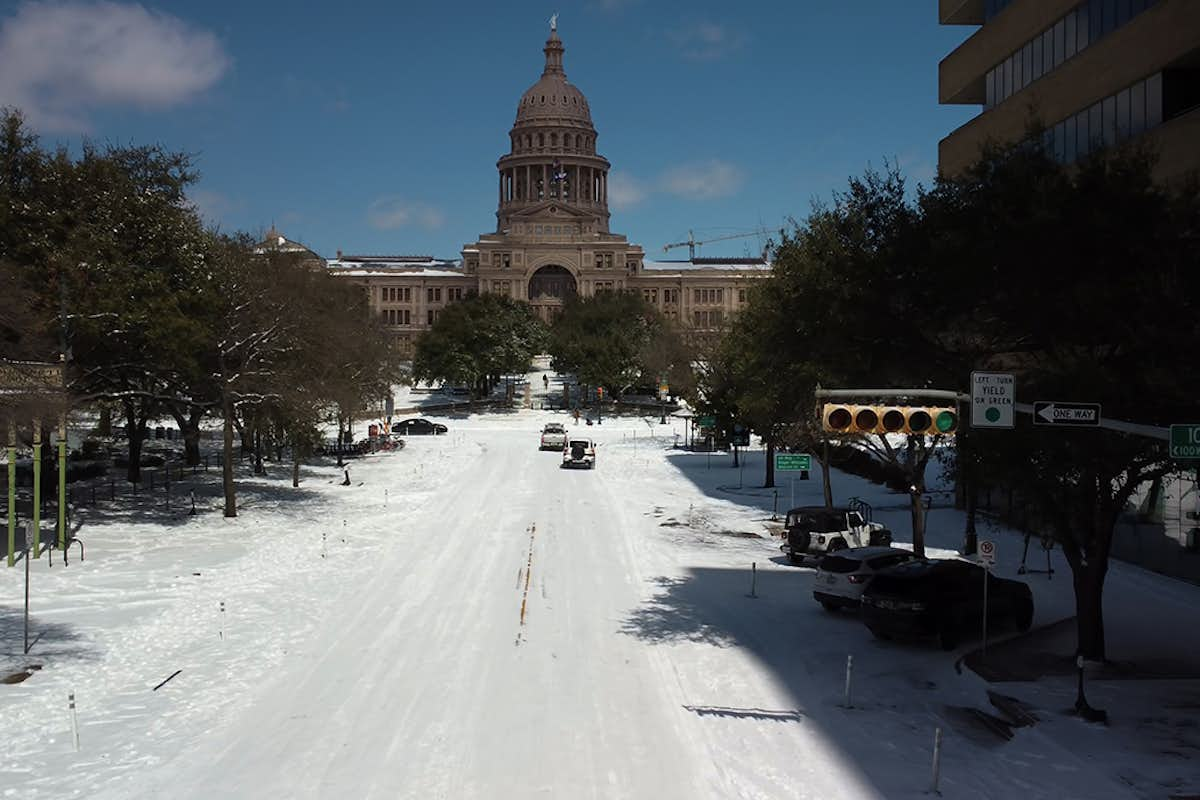
February’s deep freeze not only sunk much of Texas into a dark, powerless, snow-riddled period, it sapped the energy grid that affected millions across the state.
At the McKelvey School of Engineering at Washington University in St. Louis, the situation and the fallout that followed — the rolling or lasting blackouts, national attention, the termination of the energy group’s CEO — prompted Richard Axelbaum, the Stifel & & Quinette Jens Professor of Environmental Engineering Science, and Phillip Irace, PhD candidate and NSF graduate student fellow, to take a closer look.
This is an extended version of an analysis first published by Real Clear Energy.
In mid-February, Texans were plunged into a period of freezing cold and snow, causing an unprecedented demand for electricity. Alas, the Texas electric grid — operated largely by the Electric Reliability Council of Texas (ERCOT) — was unable to meet that demand, plunging over 4 million Texans into the cold darkness. The electricity shortage was not caused by frozen wind turbines or natural gas plants, but rather mismanagement and poor planning.
What happened in February? To appreciate what happened, one must understand that to ensure a stable electrical grid, the total supply from all energy sources must equal demand instantaneously. As the cold spell hit on Feb. 9, the demand for electricity immediately began to rise (Figure 1). Unfortunately, as temperatures began to drop, the wind (blue curve) died down, and Texas was forced to meet rising demand by ramping up its natural gas power plants (green curve).
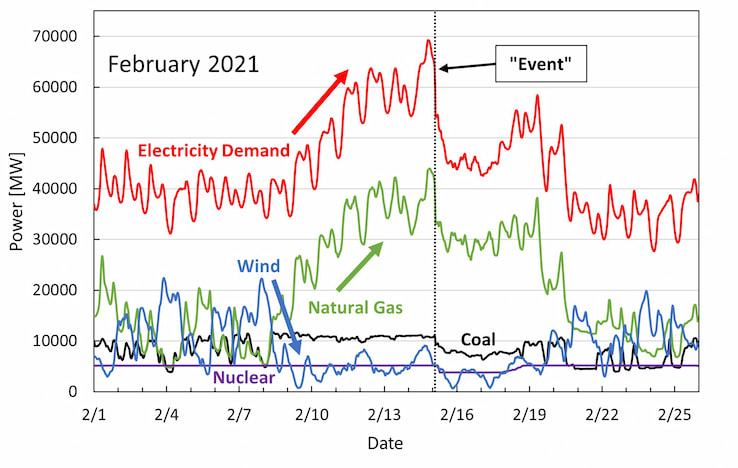
In the late hours of Valentine’s Day, as temperatures plummeted to their lowest, the dispatchable energy sources — coal, natural gas, and nuclear — were operating near maximum capacity. This is a very dangerous condition, like running your car with the pedal smashed to the floor. Eventually, something will give out. And soon, it did. A number of plants went offline, which is not an unusual occurrence for a grid the size of Texas’. However, with no reserve power to make up for the outages, the entire grid became unstable, forcing many more plants to shut down as well. Technically, what happened was the reduction in energy supply, without any reserve power to make up for it, caused the frequency in the grid to plummet. A rapid drop in frequency is catastrophic for the grid. Texas was only minutes away from a catastrophic failure that could have left millions more in the dark for days, or even weeks. To prevent that, ERCOT was forced to introduce a series of rolling blackouts.
During a typical winter, Texas has no difficulty meeting electricity demand. In the same month of 2019 (Figure 2), ERCOT was able to instantaneously meet demand for the entire month, even though there were a number of times when the output from wind power was nearly zero.
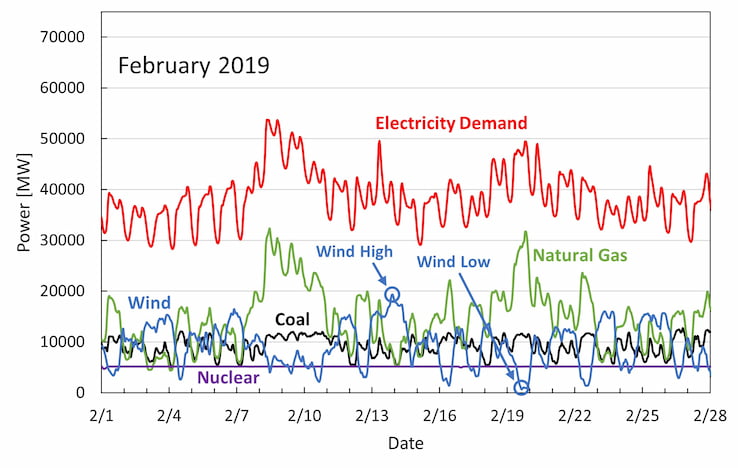
February 2021 was different. The cold snap was an atypically extreme weather phenomenon, which caused the electricity demand to skyrocket. However, this isn’t the first time Texas has experienced such low temperatures. The temperatures were lower in 1989 and 1983. Not to mention, there were 20 nights of below freezing temperatures in Houston in 1978. This year’s temperatures were certainly within the expectations of ERCOT. Moreover, in the last three years, Texas has increased its total electric capacity. So why the sudden shortage? It seemed like ERCOT was prepared. And if it was, why was the CEO abruptly let go? Wasn’t the real problem wind (if you are conservative), fossil fuels (if you are liberal) or the weather (if you are ERCOT)?
But the problem wasn’t wind, per se, nor was it fossil fuels, nor the extreme weather. The problem was ERCOT and its inability to acknowledge, and plan for, the limitations of wind and solar amidst extreme weather events. ERCOT has certainly had plenty of warning in past years that wind dies down in times of cold weather.
The data from February 2019 (Figure 2) illustrates that ERCOT officials knew what to expect from wind in the winter. Wind power (blue curve) supplied nearly 20,000 MW at times, but almost nothing at other times. In fact, it was often during times of peak demand when the wind was virtually nonexistent. The senior management at ERCOT knew they could not rely on wind in the winter. Nonetheless, Texas continued to build wind energy capacity, but more importantly, in the process, ERCOT allowed reliable coal plants to be prematurely decommissioned (Figure 3).
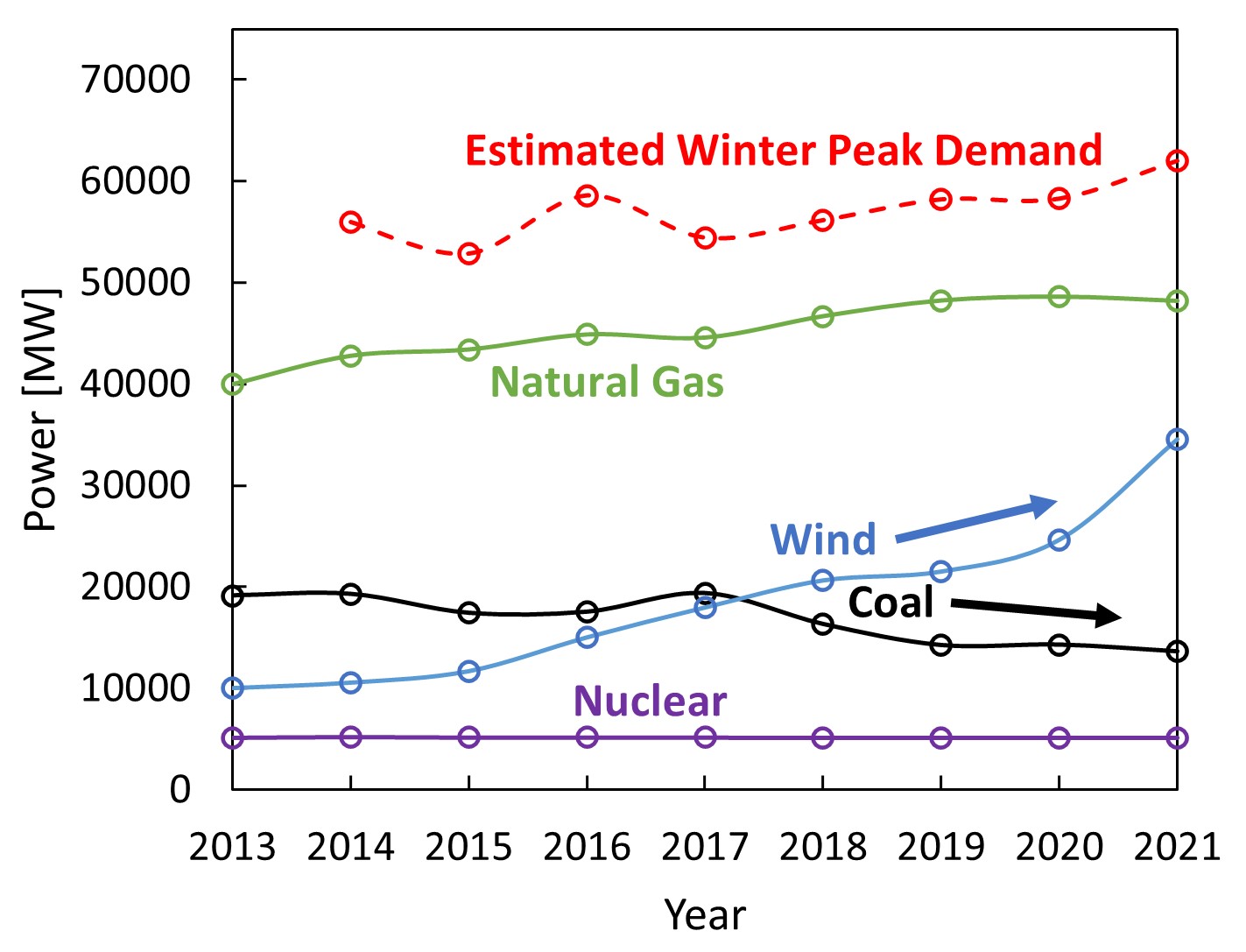
To better understand the event of Feb. 15 (Figure 4), consider the combined winter installed capacity from all “dispatchable sources” — i.e., coal, natural gas and nuclear (horizontal dashed black line). This quantity represents how much electricity can be produced if all the coal, natural gas and nuclear plants are running at their maximum installed capacity. Expecting more than 90% of this to be available is unrealistic due to occasional outages and maintenance. Thus, the available capacity was more like 60,000 MW, which was reached on the night of Feb. 14.
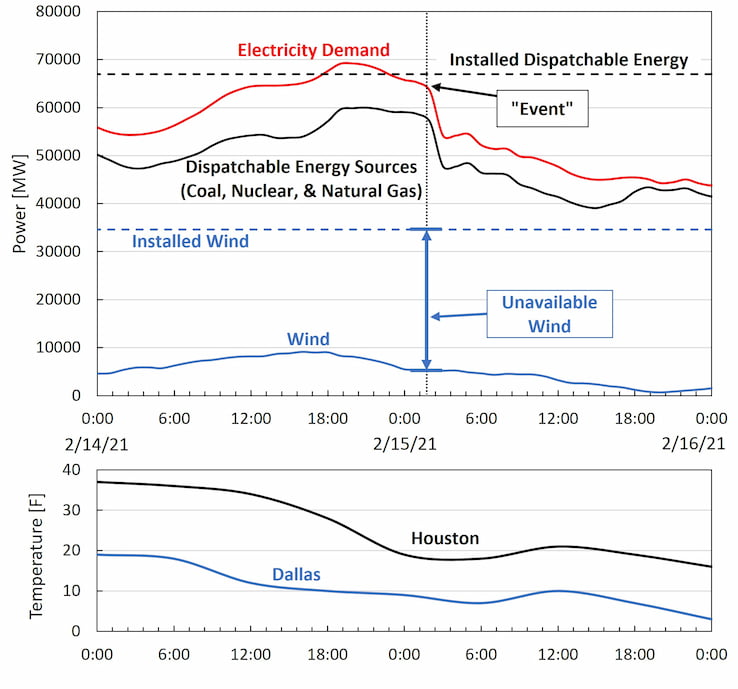
In the early morning hours of Feb. 15, about 1:30 a.m., a number of smaller plants went offline within about 10 minutes of each other, as listed in Table 1. Combined, they amounted to about 2.4 GW, which for a grid with enough reserve power would have been a manageable event. But, with all energy sources already running near maximum capacity with no reserve, this quickly dropped the frequency of the grid (Figure 5). The frequency of the grid must be maintained at 60 Hz in order to maintain stability. Rapid variations in frequency is a crisis, and this event forced ERCOT to immediately call for load shedding by inducing rolling blackouts. But the damage was already done. With no reserve power to rely on, and a rapid drop in frequency, the grid was unstable, and this led to more plants tripping offline. To avoid a total collapse of the grid, ERCOT was forced to induce many more blackouts, and this plunged Texas into a cold darkness.
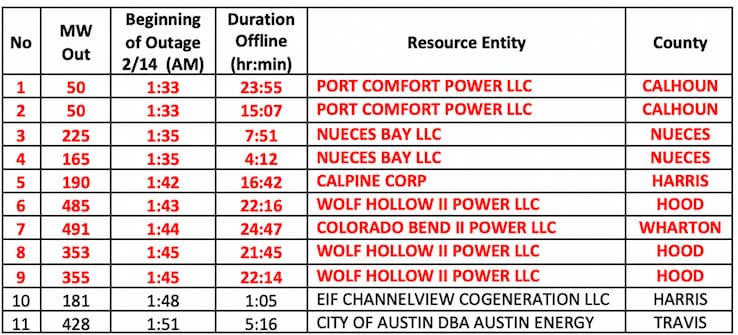
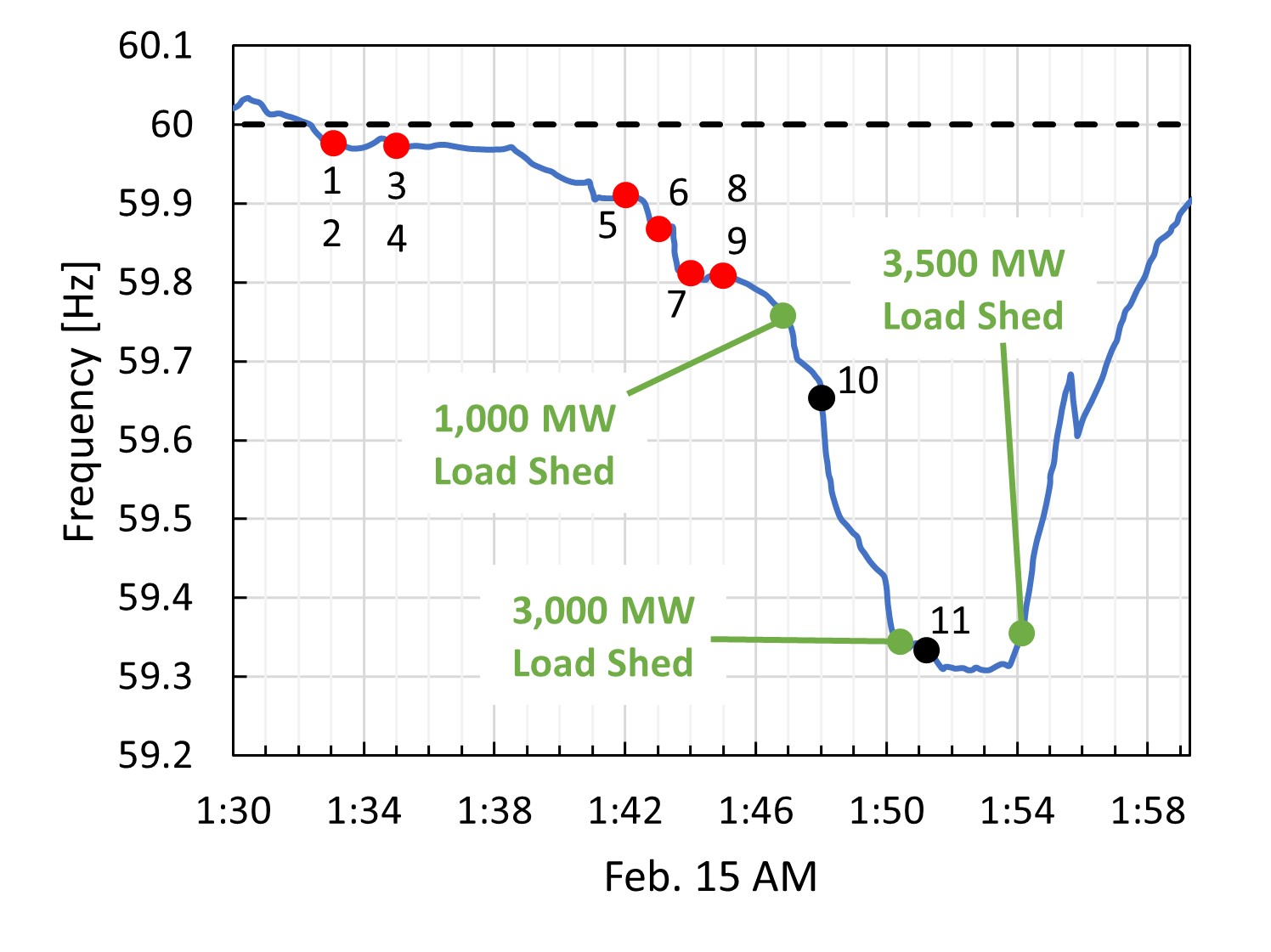
Some want to argue that this event occurred because natural gas lines froze. While at some point in the night, likely much after the blackouts began, some gas lines did freeze, Table 1 shows that this was not the root cause of the problem. Natural gas power plants in five different counties went offline at nearly the same time. The temperatures in these counties were much different, as was the construction of the gas lines. The odds of them all freezing at the same time is essentially zero. While the exact cause of these simultaneous outages may never be revealed, when the frequency of the grid drops, this leads to an instability of the grid that can force many more outages. Without any reserve capacity available to quickly ramp up when these plants went offline, the condition was dire. Outages of this magnitude shown in Table 1 typically occur without a major incident, so why wasn’t Texas prepared with more reserve capacity? You might say they tried to be, because they did increase the total grid capacity (Figure 3). But they did this by installing more intermittent wind energy. Wind energy is capable of producing over 21,000 MW in Texas (as seen in Figure 1), but wind is not always available in winter. During February 2021, energy from wind steadily decreased, leaving the other energy sources to be strained to the max in a futile attempt to meet demand, and, ultimately, they failed.
The greater issue that this catastrophe revealed, however, is this: The utility industry has long known that to have a stable, secure grid at all times requires a diverse mix of reliable energy sources. In the past, this meant a healthy mix of coal, gas, nuclear and hydro. Now, as the industry works to reduce its carbon footprint, wind and solar have become part of the mix, and the challenges of replacing reliable energy sources with intermittent energy sources are becoming apparent. The coal plants that ERCOT allowed to be decommissioned were built for a reason. They needed them for a secure grid with a sufficient amount of reserve power. But they were replaced with intermittent wind turbines. When ERCOT allowed those plants to be decommissioned and replaced with wind, they took a significant risk. ERCOT is responsible for ensuring a reliable grid, and failing to acknowledge this risk was a serious mistake.
Here is the takeaway: Many experts in the utility industry are painfully aware that if we are going to add wind and solar responsibly, we need to invest an enormous amount of money into backup power or batteries. However, these same experts seem unwilling to speak out for fear of being criticized; they would have to tell their shareholders that it is very expensive to have reliable power from wind and solar. Perhaps the abrupt termination of Bill Magness will send a message to those in the industry who have been silent – that it is your duty to speak up. Once they do that, Texans will not have suffered in vain.





